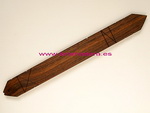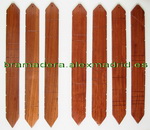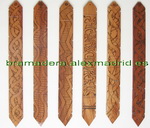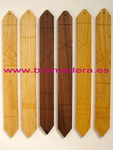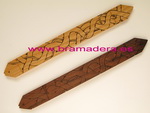BULLROARERS |
HISTORY - MAKING - USE - DESIGNS - PURCHASE A BULLROARER
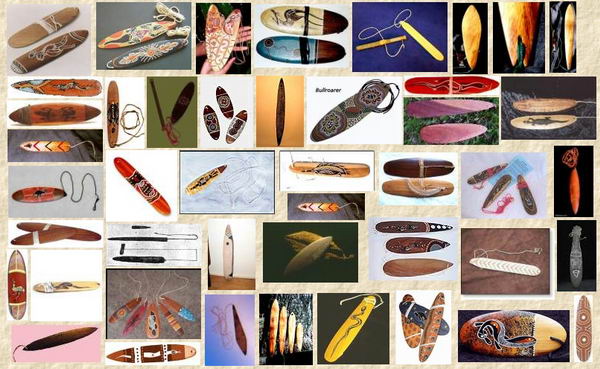
My video in YouTube: my own design of a bullroarer.
If you don´t see the video,
please allow Internet Explorer to show it by clicking on the yellow information bar that warns about active content. Don´t worry, the content in this page is safe.
Click here if you don´t see a video
1.- Introduction. The photos in this page are examples of bullroarers. As its own
name says, a bullroarer is an instrument that makes a noise similar to a bull´s roar. It is a flat piece of wood in a ovoid/oval or even rhomboid shape and usually 8”-20” long. There´s a small hole in one of the ends in order to
tie a string. Whirling the bullroarer and making it turn on its own axis makes the string go tight and loose as it twists and untwists, producing this particular sound. In theory, the pitch of the noise depends on: a)the shape,
weight and dimensions of the piece of wood, b) the elastic quality of the string and its lenght and c) the speed you make it whirl. A lot of people has seen a bullroarer in the movie “Crocodile” Dundee II, in which
it is used by Paul Hogan as a bush-phone to call his australian aborigines friends. In some places of Australia (where it can be found as a toy or souvenir for tourists) it actually seems to be related to religious ceremonies, and
this instrument can be found also in North-American native tribes and Melanesian tribes. In the Ancient Greece it was known as rhomb (rhombos-rhombus), which means run through, turn round and round. In Spain bullroarers are
known long ago, and have been used as wolf-scarer and cattle caller by sheperds, a toy for kids or even at traditional celebrations to make noise. It has also been used in theatrical plays to imitate the sound of the wind.
A lot of archaelogical remains of this instrument have been found in Europe from the Paleolithic Period (see Experimental Archaelogic Journal in spanish: The spanish word for bullroarer is bramadera, and it can be also known as rombo, zumbadera, zumba, palo zumbador, placa zumbadora, and sometimes,
wrongly, churinga (tjurunga, txuringa). The french word is “rhombe” and the german word is “schwirrholz”. From the point of view of music, the bullroarer is considered a free rotational aerophone, whose
sound has a fundamental frequency of 70 Hertzs. Interestingly, this frequency is the same of another australian instrument, the didgeridoo or didjeridu. Profesor Neville H. Fletcher, from the
2.-How to make a bullroarer. A 8mm (0.3’’) thick pinetree board can be used, but it will do better a higher density wood as beech or oak, for instance. I recommend a string made of polypropylene fibers as the one in the picture, because it is easy to twist but resistant, of at least 70 cm (27.5”) long . The dimensions in the picture are given only as an example: variations will cause a change in the pitch of the sound. The corners can be rounded too. The carving on the end near the hole is necessary to prevent the knot from moving. You can use three single knots. The bullroarer section or profile that produces the best sound is the first one in the graphic below.

3.- How to use it. In first place, safety rules:
-Use it only outdoors in an open space, far away from people or obstacles.
-Wear gloves, goggles and/or face protection unless you are an expert.
-Don´t use it under windy conditions.
-Change the string when necessary.
NOTE.- No responsibility will be held for any damages caused by this instrument. Use at your own risk.
You can start just by holding the string with your hand at your waist and whirling the bullroarer at your side like a sling [picture 2], but if you don´t hear the noise is because it doesn´t
spin, so in first place it is better to make it spin with your other hand [picture 1]. With some practice, you will also be able to start by moving your arm over your head, allowing more lenght of string to be used [picture 3].
To stop, slow down softly (if you stop suddenly you may hit your face).
You must roll the string around your middle finger and then hold the string between your forefinger and thumb to make it whirl. You can also tie the string to a stick or to a piece of strong wire. |
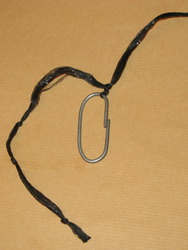
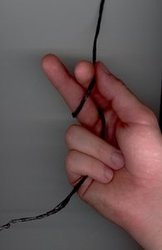
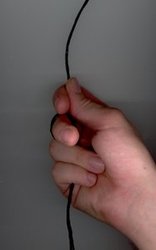
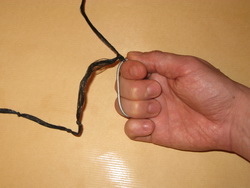
4.-My colection of bullroarers:



This one is made with beech wood. 45 cm (17.8”) long, 5 cm(2”) wide and 9 mm(0.35”) thick.

These three are made of white oak. They are 45 cm (17.7 ”) long, 5 cm (2’’) wide and 6 and 8 mm (0.24” and 0.3 ”) thick.

Ebony.


White Oak, 33 cm.

Sapelly, 50 cm long.
Sapelly, 30 cm long.
5.- My own design of bullroarer: after many tests, and inspired by a spanish bullroarer, I have developed a special design which spins and can be whirled easily at high speed, creating a powerful sound. This model of bullroarer is on sale.

Beech: 45 cm (17.7 ”) long, 5 cm (2’’) wide and 6 and 8 mm (0.24” and 0.3 ”) thick.

Black ebony, my favourite. Same dimentions as the one before but 7 mm(0.28”) thick. Due to higher density in comparison with beech wood, more power can be applied during whirling and the sound is more impressive. Teeth are smaller.

White oak. 45 cm (17.7 ”) long, 5 cm (2’’) wide and 8 mm (0.3 ”) thick.

Danta - Kotibe. It is 32 cm (12.5”) long, 4.5 cm (1.8”) wide, 6 mm (0.25”) thick.
If you are interested in purchasing a bullroarer ( 45 cm (17.7 ”) long, 5 cm (2’’) wide and 8 mm (0.3 ”) thick), the prices and shipping costs
are the following:
Some examples of the bullroarers available; raw and with pyroengraving: Each bullroarer is
finished by hand and has a different and unique decoration. I have chosen these specific hard wood timbers because of the good properties for this device: density, rigidity and stability.
Contact me sending an email to |
|||||||||||||||||||
NEW! You can buy my bullroarers in Madrid at Tununtunumba. This shop is close to the city center and the prices are the same that you can see on my website.
The address is Tununtunumba - c/ Santa María, 34 - 28014 (Madrid) - Spain - (+34) 914 200 450

Click to visit Tununtunumba’s website in english, BimBamBoom
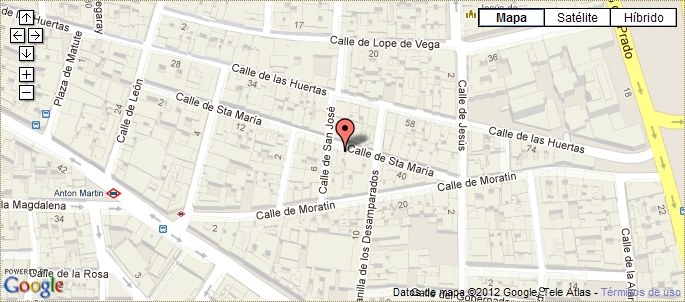
Contact me if you have any questions or comments. I
 Kotibe
Kotibe 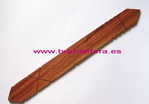
 Birch
Birch 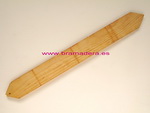
 Ash
Ash 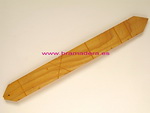
 American Walnut
American Walnut 